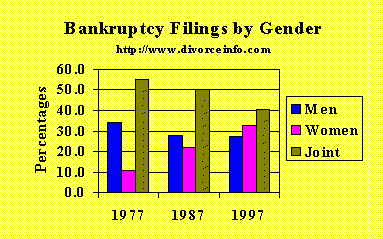Over the last 20 years, women have filed bankruptcy in greater numbers in relation to men, and in greater numbers in relation to joint filings. Is this because of divorce? Hard to say.

The source for this chart is small — it covers only the state of Nebraska. The researcher, Oliver B. Pollak, analyzed consumer bankruptcy filings in Nebraska in 1977, 1987, and 1997 for the Commercial Law League of America. Every indication I have, however, is that his findings are typical of what’s happening in other states as well.
This means that the percentage of women filing bankruptcy petitions has almost tripled during the last 20 years. During that same period, the percentage of men’s petitions dropped by 20% and the percentage of joint petitions dropped 26%. One last thought about all this. Please don’t read this as saying that there are fewer men filing bankruptcy and fewer joint filings. To the contrary. The raw numbers of bankruptcies have more than tripled during this same period. If you were so bold as to interpolate the Nebraska results nationwide, you would estimate that the raw number of men filing bankruptcy increased from about 100,000 in 1977 to 240,000 in 1997, an increase of 140%. In a similar way, although joint filings have declined dramatically in percentage terms, you would estimate that they have actually increased in raw numbers, from 165,000 to 365,000, an increase of more than 120%
Now if you really want to explore the limits of the numbers, take a look at the change in the raw number of women filing bankruptcy during this same period. Again, making the dangerous decision to interpolate Nebraska percentage nationwide, you would estimate that the number of women filing bankruptcy has increased from 33,000 or so up to 290,000, an increase of more than 750%.
Is this related to divorce? It certainly has to be counted as one of the factors, but not the only factor. The divorce rate hasn’t increased nearly so dramatically. My guess (and it’s only a guess, so please hear it with that in mind), is that it’s a combination of divorce, a change in the workplace expectations of women, an increase in the incidence of single parent families, a change in the ability and inclination of women to take on debt, and of course a huge increase in our willingness as individuals to use bankruptcy protection.